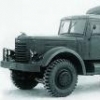Looks like a common TRD-72-something Mack tranny of those times. The main box is an over with that "mirror: shift pattern" if I understood correctly what you're talking about. I mean 4th (direct) is down and the 5th (overdrive) is up.
The reason is, when you shift direct you slide a sliding clutch up front in the tranny to unify the main shaft with the spigot (the pinion). This way you get a "solid straight shaft" through all the transmission (the main box) which means a direct gear (actually no gear). As long as you slide the sliding clutch up front you move the shift lever to the rear (it has a ball moint in the tranny top cover). So the direct is normally with the lever pulled back.
And when you put the lever up front in the same cluster it slides the clutch into another gear wheel, the first on the main shaft after the constant mesh set. IF that gear is lover than 1.0 ratio you get slightly lower ratio which would be #3. So you're Ok shifting 1st left-up, than 2nd left-down, than 3rd right-up and 4th (direct) right-down.
Or if we count starting from the crawl gear which shifts against the reverse it would be 1-2-3-4-5 with 5th direct.
So life's good. Until we desire an overdrive tranny. Practically it's done by installing a fast set of gears in place of the 3rd gear set. Which was slower than direct but becomes faster. Physically tranny remains the same. But when you shift right-front you get a ratio faster than 1.0. So you have first shift to direct which is right-down (or back).
Later series transmissions were bult the same way (including T200 series). But correction was done in the shifter rails arrangement. There's a kind of a balancer lever in the top cover or I don't know how to call it correctly. Design is when you put the shift lever right-front it moves the rail and the fork also up front due to double reversing by that balancer setup and the shift tower ball joint. So you're getting the overgear after the direct one following the normal shift sequence.
Speaking the compound it could be of different ratio. Some trannies (duplex) had if of 1/37 (if I'm not wrong) so you have "halves" for splitting (usually for Lanova Diesels). Gas jobs had wider revs range (up to 3000RPM's against 2000 with diesel) so the truck could drive with no splitting and the aux box could be slower for off road or slow pull operations.
Actually the compound could also be a triplex or quadriplex attached to that same main box.





